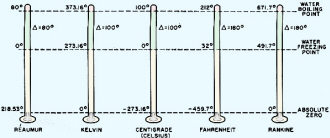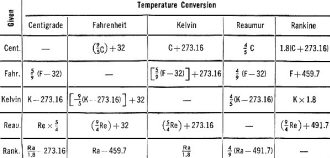Temperature Conversion
|
|
You've heard of the Fahrenheit, Centigrade (Celsius), Kelvin, and Rankine temperature scales, but what about the Réaumur scale? This 1965 Electronics World magazine article presents all five along with formulas for converting between them. Each temperature scale is named in honor of its creator. Daniel Gabriel Fahrenheit came up with his scale where, under standard atmospheric pressure (14.7 lb/in2) pure water freezes at 32° and boils at 212°. Anders Celsius decided a more sensible temperature scale would place freezing water at 0° and boiling water at 100°. William Thomson, 1st Baron Kelvin set his scale, which has been adopted as the International System of Units standard, declares 0° to be absolute zero, where no thermal energy is present. William Rankine, of ideal heat engine fame, combined Fahrenheit's scale with Kelvin's absolute zero concept. Lastly, but not leastly, René Antoine Ferchault de Réaumur selected the freezing point of water to be 0° and the boiling point to be 80°, primarily to accommodate his preference of alcohol over mercury as a thermometer medium. There you have it - my version of the brief history of temperature scales. Here is my webpage with temperature unit conversions. Temperature Conversion By J. M. Bruning There are five major temperature scales in use at present. These are: Fahrenheit, Centigrade (Celsius), Kelvin (Absolute), Rankine, and Reaumur. The basic relationship among these scales is shown in Fig. 1. Because measurements can be made in any of these scales, conversion from one to the other can be performed by using the conversion data shown in Table 1.
Posted December 15, 2022 |
|


